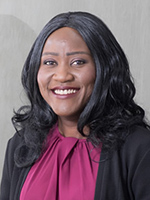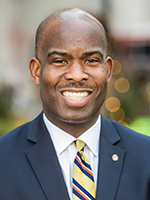‘Impactful Interactions’ Symposium Explores How to Dismantle Legal Barriers Faced By Individuals with Disabilities
October 21, 2020
By Analisa Goodmann and Brittany Cruz
Does the law help or hurt people with Autism Spectrum Disorder (ASD)? This was the central question addressed during a daylong symposium, titled “Impactful Interactions: Autism Spectrum Disorder and the Legal System,” hosted by Drexel Law Review on October 2, 2020.
Daniel Filler, dean of Drexel University Thomas R. Kline School of Law, began the conference by explaining how the American legal system has been slow to recognize and address institutional barriers that individuals with ASD and intellectual disability (ID) face.
The symposium’s goal, said Filler, was to “prompt a robust conversation on the barriers that arise for people with ASD and to talk about possible ways of thinking about meaningful change.” The focus especially being on dismantling barriers in the criminal law, education, and healthcare systems.
“My biggest hope for today,” concluded Filler, “is that we may not only give ideas to the many practitioners and scholars who are visiting today, but we may gain broader insights into solving these massive national and social problems.”
Panel One: Reconciling the treatment of ASD in the Criminal Justice System
 Dianah Msipa, LLD candidate, LLM, LPC, LLB, Legal Researcher, Inclusion International
Dianah Msipa, LLD candidate, LLM, LPC, LLB, Legal Researcher, Inclusion International
Opening the symposium, panelists Dianah Msipa, LLD candidate, LLM, LPC, LLB; Samantha Crane, JD; and Colleen Berryessa, PhD, spoke about the need to address the experiences of individuals with ASD in the criminal justice system.
Msipa, who is a legal researcher at Inclusion International, discussed Lesotho’s case of Koali Moshoeshoe, which involved a man with disabilities being declared not competent to testify as a witness. Ultimately, the court declared that § 219 of the Lesotho Criminal Code, which states that persons with intellectual disabilities are not competent to act as witnesses, was unconstitutional. While this ruling may have been a step forward, Msipa argued that the Court “missed a golden opportunity” to articulate the right to legal capacity and the right to access justice and to address providing accommodations in courtroom settings.
Crane, who is the legal director at Autistic Self Advocacy Network, noted that “racism intersects with disability bias” in all aspects of the law. Her case studies included that of Darius McCollum, a man with ASD who dreamed of being a public transit driver and often impersonated drivers on buses and trains. In 2018, McCollum was involved in an accident while impersonating a driver. He was found not responsible “by reason of mental defect,” which resulted in McCollum being confined to a psychiatric facility until he could be certified as no longer being disabled. This conditional release is problematic because an ASD diagnosis cannot be changed.
Berryessa ended the panel by arguing that members of the court must be equipped with appropriate training and resources to recognize and understand the symptoms of ASD. Berryessa, who is an assistant professor at Rutgers University’s School of Criminal Justice, stated that such training and resources are critical in the courtroom, because individuals with ASD may exhibit differences in social interactions that can often be misinterpreted and lead to adverse outcomes.
Opening Keynote Address: Transition Justice?: How Adult Students with Intellectual and Cognitive Disabilities Fall Through the IDEA’s Cracks
 Michael Ashley Stein, PhD, JD, MA, Executive Director of the Harvard Law School Project on Disability
Michael Ashley Stein, PhD, JD, MA, Executive Director of the Harvard Law School Project on Disability
In their keynote address titled “Transition Justice?: How Adult Students with Intellectual and Cognitive Disabilities Fall Through the IDEA’s Cracks,” Michael Ashley Stein, PhD, JD, MA, and Hezzy Smith, JD, discussed the issues in implementing seminal disability right legislation: the Individuals with Disabilities Education Act (IDEA).
“IDEA in many ways is remarkable. Nevertheless, it’s still undergoing growing pains,” said Stein, who is the co-founder & executive director of the Harvard Law School Project on Disability (HPOD). Such growing pains include the many areas in which pushback against the statute’s requirements has occurred. At the root of most of this pushback is the limited recognition of the rights of students with ASD and/or ID.
According to Smith, who is a research associate at HPOD, this may be driven, in part, by the fact that IDEA was written as a civil rights statute not a human rights statute and assumes that education rights end with post-secondary school. This results in students with ID being treated as second-class students in their higher education institutions—if they are even able to gain admittance to these institutions in the first place.
A specific example of this is the all too common practice of colleges failing to provide accommodations such as individualized education programs (IEPs) for students in dual-enrollment programs. This and other failures have led Stein and Smith to question whether the promise of IDEA is actually being upheld in practice.
Panel Two: Unequal Equality: How our Education System is Failing Americans with ASD
 Terry Seligmann, JD, Emerita Professor of Law, at Kline School of Law
Terry Seligmann, JD, Emerita Professor of Law, at Kline School of Law
Compounding the growing pains of IDEA within tertiary education are the growing pains experienced within primary and secondary education, which was the focus of the second panel, titled “Unequal Equality: How our Education System is Failing Americans with ASD,” which featured panelists Darlene Hemerka, JD, staff attorney at The Public Interest Law Center; Lewis Bossing, JD, senior staff attorney at Bazelon Center for Mental Health Law; Kline Emerita Professor of Law Terry Jean Seligmann, JD; and Jasmine E. Harris, JD, professor of law at University of California – Davis, School of Law.
The majority of issues surrounding IDEA’s implementation within secondary education is the vague language both within IDEA and the limited federal case law. Only two cases regarding IDEA, according to Seligmann, have been heard by the Supreme Court: Endrew F. v. Douglas County School District (2017) and Board of Education of the Hendrick Hudson Central School District v. Rowley (1982). The Rowley case resulted in the Rowley Standard, which established requirements regarding the development of an IEP.
The Endrew decision built upon Rowley, and the Court tried to raise the bar for what schools must do in providing an education to ID students, since Rowley provided little substantive guidance. However, the lower courts’ interpretation of Endrews has lost sight of this, according to Lewis, as minimal provisions continue to be the norm.
In light of these deficiencies, Hemerka has developed guidelines on how to use lawsuits, including class action lawsuits, to challenge the ways in which schools are interpreting how to provide a free appropriate public education (FAPE), the requirement established in IDEA. However, bringing a lawsuit is complicated and requires parents to first exhaust all administrative remedies, including filing a due process complaint, according to Hemerka.
Harris closed the panel by discussing the ways in which students with disabilities are often more likely to experience failures of the education system if they are minority students and/or are from lower socioeconomic standing. This pattern can be seen in such cases as Mills v. Board of Education of District of Columbia (1972). All seven of the plaintiffs in Mills were Black children from lower socioeconomic backgrounds, according to Harris. Therefore, intersectionality also must be considered when trying to close the gaps in IDEA’s implementation.
Presentation: The Changing Medicaid Landscape for Autistic Individuals
 Lindsay Shea, DrPH, MS, Assistant Professor, Health Management and Policy, at Dornsife School of Public Health
Lindsay Shea, DrPH, MS, Assistant Professor, Health Management and Policy, at Dornsife School of Public Health
Kline Professor of Law Robert Field, PhD, JD, MPH, and Dornsife School of Public Health Assistant Professor Health Management and Policy Lindsay Shea, DrPH, MS, began the afternoon portion of the symposium with their presentation, titled “The Changing Medicaid Landscape for Autistic Individuals,” which explored the Medicaid landscape for individuals with ASD.
Field began the presentation by giving a brief history of Medicaid, including state-specific decisions, enrollment numbers, and extent of coverage. He also spoke about federal waivers, which have expanded the home- and community-based services that are critical for individuals with ASD.
Shea went on to discuss how individuals with ASD often rely on Medicaid for health care because of poor employment outcomes; therefore, conducting research on Medicaid is a “key way for [policymakers] to really understand” who is using Medicaid services and for what, which can inform policy decisions.
Indeed, recent Medicaid data has revealed an increase of individuals with ASD between the ages of 18 and 24 enrolling in Medicaid. Since the most recent research primarily focuses only on children, this new data on adults expands possible research areas. By collecting and analyzing Medicaid data, researchers can understand how better to support individuals with ASD.
Panel Three: Navigating a Minefield: ASD and the American Healthcare System
 Derek S. Green, JD, Philadelphia City Councilmember at-Large
Derek S. Green, JD, Philadelphia City Councilmember at-Large
Panel three was titled “Navigating a Minefield: ASD and the American Healthcare System” and was moderated by Partner at Goodwin Law’s Life Science group and Healthcare practice Delphine O’Rourke. Each panelist had some personal connection to individuals with ASD, which has fueled their commitment to advocacy and policy work.
Derek S. Green, JD, is a Philadelphia city councilmember at-large, but he says his most important title is father. He spoke about his and his wife’s experiences advocating for their teenage son, who has ASD. As his son finishes high school, Green is becoming familiar with the challenges that adults with ASD face, and he is working to identify how to meet those needs. However, Green emphasized that the needs of individuals with ASD are unique to the individual. “When you meet one person on the spectrum, that means you’ve met one person on the spectrum. There’s a whole diversity of experiences and relations and capabilities for young adults,” he said.
Panelist Stephanie Keeney Parks, MA, said her son, who has ASD, is a “driving force” behind her research which focuses on the intersection of race and ASD. In a recent study, Parks, who is a doctoral candidate at University of California – Los Angeles’s Department of Anthropology, found that clinicians are often trained in a way that may create barriers for minority patients. “When the clinicians go and give these diagnostic tests to a Black kid, (...) if the child does not know to code switch into what are white linguistic norms that can get scored as deviant and problematic and change a kid’s autism score,” she said.
Exploring the intersection between ASD and sexual orientation, Victoria M. Rodríguez-Roldán, JD, a senior policy manager at AIDS United, noted that individuals with ASD who also identify as LGBTQ+ often have their coming out ascribed not to their sexual or gender orientation but to their ASD diagnosis. This misreading of LGBTQ+ identity as a symptom of ASD can result in individuals being forced into a sort of conversion therapy. To help prevent this, Rodríguez-Roldán, who has ASD, argued that advocacy needs to be led by individuals with ASD, in order to ensure that their needs are being met.
Final Keynote Address: Racism, Eugenics and ASD
 Lydia X.Z. Brown, JD, Director of Policy, Advocacy, & External Affairs at the Autistic Women and Nonbinary Network
Lydia X.Z. Brown, JD, Director of Policy, Advocacy, & External Affairs at the Autistic Women and Nonbinary Network
The first half of the lecture given by Director of Policy, Advocacy, & External Affairs at the Autistic Women and Nonbinary Network Lydia X.Z. Brown, JD, focused on the way in which the United States’ history of eugenics continues to underlie ableism, white supremacy, and other systems of power that are embedded in American institutions, resulting in discrimination and violence toward neurodiverse individuals and individuals with disabilities.
Eugenics is “embedded in all facets of the United States, in our entire jurisprudential history and in our entire civil system and in our entire criminal system,” stated Brown. Eugenics also drives ableism by underpinning ableism’s key tenant that certain people’s bodies and brains are considered normal and desirable while anyone with a differing body or brain is considered inferior. Ableism in the United States, with the country’s history of slavery and genocide, is inherently anti-Black and anti-Indigenous People. The combination of these histories and systems of power, which continue to exist, have created specific barriers that neurodiverse individuals and people with disabilities face throughout the country.
Within the legal system, people with disabilities face systemic discrimination and violence as a result of several laws, many of which were established at the height of the eugenics movement. For example, the 1927 case of Buck v. Bell set legal precedent to sterilize people who had been institutionalized for perceived intellectual differences. This law possibly facilitated the country’s long history of forced sterilization of Black, Latinx and Indigenous individuals, which is still occurring today.
In health care, people with disabilities face myriad forms of discrimination, which often lead, at best, to receiving inferior care and, at worst, result in violence. Brown gave the example of Judge Rotenberg Center, a special needs day and residential school in Canton, Mass. For decades the Center used electrical stimulation devices (ESD) on students as a form of punishment when students “misbehaved.” Brown noted that the practice was finally banned earlier this year by the Federal Drug Administration. Prior to this ban, the practice had been condemned by the United Nations twice.
In light of these barriers, violence and systemic discrimination people with disabilities face, Brown ended the conference by suggesting we move away from the imagined futures encompassed in the ideologies of eugenics, ableism and white supremacy. In this future, only white, “able” bodies are valued, while the imagined future within the disability justice framework moves beyond and past the laws which are underpinned by these discriminatory and violent ideologies. In a future with disability justice, the world would be one where every mind-body “can all receive the care, rest and love that we deserve,” according to Brown.
Conference Recording